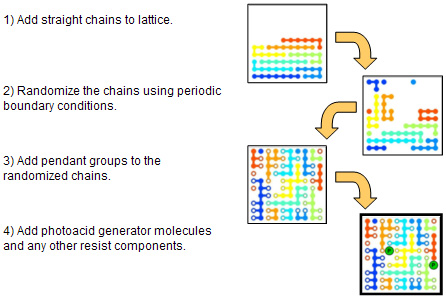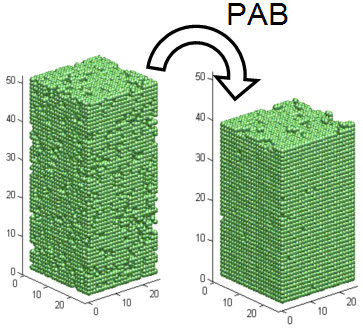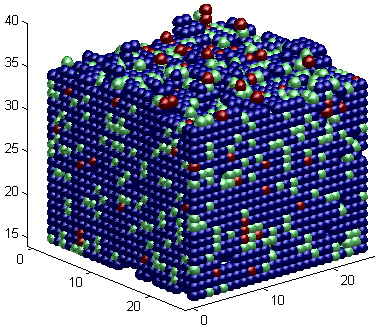Film Creation |
The lattice model for a photoresist film is based upon fundamental and measurable
resist properties. To specify the polymer component, both the
average degree of polymerization and the standard deviation of the distribution of
degree of polymerization are input. It is also necessary to know the
average fraction of the polymer repeat units that are chemically
protected. Concentrations of other photoresist components, most notably
the PAG loading and presence of residual casting solvent, must also be
quantified. Knowledge of the chemical composition of the photoresist
enables calculation of the appropriate population of each component in the
lattice. Each component can then be added sequentially until the desired
concentration is present. In the first step of lattice creation, chains
are added to the lattice by stringing cells together to the desired chain
length and chain length distribution. These chains are then randomized via
many simulated reptation-type moves that have the effect of introducing
bends into the chains and eventually randomizing their conformation.
Periodic boundary conditions are employed so that the simulation is
effectively modeling an infinite plane of resist material. After
randomization, pendant groups are added to random positions on the chains
to represent blocked sites on the polymer chains. This approach produces a
normal distribution of blocking fractions for the chains. Photoresists
typically consist of random copolymers, so this distribution of blocking
fractions is an accurate representation of what would be found in an
actual resist. Finally, PAG molecules are included by adding PAG units to
random lattice vacancies until the required concentration of PAG has been
achieved. Other components, such as added base and residual casting
solvent, may be added in a similar manner.

|
Click here to download a movie that
illustrates how chains are added to an empty simulation lattice
(15.7MB).
|
After creating the resist model in this manner, the lattice approximates
the configuration of the film after the spincoating step. It is then
necessary to simulate the post apply bake (PAB) step. During the PAB,
intermolecular interactions are important in the processes of solvent
evaporation and film shrinkage. A Monte Carlo simulation is performed that
allows the effects of specific intermolecular interactions to be
considered. (Details of this simulation have been published, and the
references are available on this website.)

|
Click here to download a movie
showing solvent evaporation and film shrinkage during the PAB simulation
(3.4MB).
|
|
After the PAB simulation, the resist lattice model contains a realistic
configuration of polymer chains, photoactive molecules, solvent, free
volume, etc. This lattice model is the starting point for the next
simulation module, the exposure step. |
 |
|
Next:
Exposure Module
|



